Looking for Stainless Steel boiler tubes Suppliers in Indonesia, Leading Stainless Steel Boiler Tubes Distributors in Indonesia, Largest ASTM A213, A312 SS TP Boiler Tubes Dealers in Indonesia, Top Quality Stainless Steel Boiler Pipes Stockholder in Indonesia, Reliable Exporter of UNS SS Boiler Tubes in Indonesia
boiler tubes, SS Boiler Tubing, ibr boiler tube specification, seamless boiler tubes manufacturers, tata boiler tubes, boiler tube manufacturers in india, boiler tubes material specifications, boiler tubes suppliers in india, water tube boiler operation, fire tube boiler, Boiler Tubes High Pressure High Temperature, Boiler tubes and pipes - steel seamless tubes, Boiler Tube Company, Boiler Tubing
Are Looking for Stainless Steel Boiler Tubes in Indonesia, We can offer a comprehensive range of SS DIN 1.4301 Boiler Tubing. Carrying extensive inventories of Stainless Steel JIS SUS Boiler Tube in Indonesia, Click here if you want to buy Pipes or want to learn about Stainless Steel Boiler Pipes, Reliable Exporter of SS in Boiler Tubing in Indonesia
- Stainless Steel Boiler Tubing in Grade : 304, 304L, 304H, 310/310S, 310H, 316, 316L, 316H, 316Ti, 317/317L, 321/321H, 347/347H Boiler Tubes, Pipe Tube Standard and Specifications, Stainless Steel Tube Specifications, ERW/CEW Boiler Tubes, Industrial Boiler Types, Boiler tubes - for pressure equipment, ASTM/ASME / European standards (Boiler pressure code)
We manufacture Steel Tubes by cold drawn process to ensure the most accurate dimensional tolerances.We provide Stainless Steel Boiler Tubing and Pipe in all shapes and sizes and with any specifications that the clients
Industrial Boiler Types
Fire Tube or Shell Boilers
This is the most common type of boiler used in small and medium sized industrial installations. Fire tube boilers are often produced as ‘packaged’ units complete with pumps and control system, requiring only connection to a suitable water and fuel supply before commencing operation.
In fire tube boilers the flame and heat gases from combustion are confined within tubes arranged in a bundle within a water drum. Water circulates on the outside of the tubes. As the water changes to steam it rises to the top of the boiler drum and exists through a steam header.
Fire tube boilers are efficient steam generators for low to medium pressure steam requirements usually below 15 bar, although shell boilers operating up to 30 bar are known and steaming rates up to 70,000 kg/hr. Operating at higher pressures and steaming rates requires thicker plates and tube walls making the design less economic.
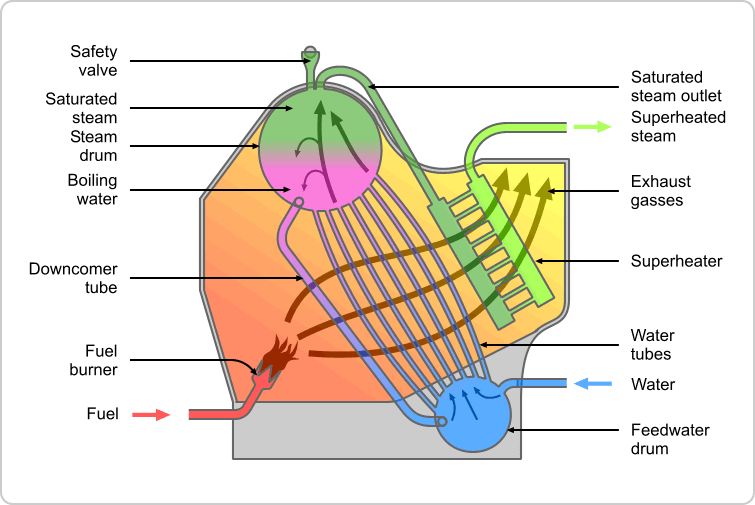 WATER TUBE BOILERS
WATER TUBE BOILERS
The water tube boiler differs from the fire tube in that the flame and hot combustion gases flow across the outside of the tubes and water is circulated within the tubes. Fuel combustion occurs in a furnace and some of the water tubes usually form the furnace walls.
Early boilers were of this type although in the most common type – Lancashire boilers – there were no smoke tubes to recover energy from the exhaust gases, hence the poor efficiency of these early designs. In a simple water tube circuit, steam bubbles form on the heated side of the tubes. The resulting steam-water mixture has a density less than that of cooler water on the unheated side and rises, creating a circulation through the system. The steam bubbles rise until they reach the steam drum where steam is released from water into the vapour space.
Water tube boilers may have natural circulation, where circulation of water between a steam drum at the top and a mud drum at the bottom occurs due to density differences. In forced circulation boilers a pump provides the water circulation, Figure 7. This gives a more positive control of the circulation pattern than that created simply by density differences. This is important if the boiler operates over a wide capacity range.
Water tube boilers are commonly used in electrical utilities and large manufacturing sites where requirements are for large capacity and/or high pressure steam. Most water tube boilers are built on site, although smaller ‘packaged’ units are becoming available.
Other Boiler Types
Whilst fire tube and water tube boilers are the most common types, especially where high steam capacity is required, other designs do exist.
i) Coil Boiler
The basic design is for feedwater to be pumped to single or multiple coils arranged around a burner. The heat input and fluid flow produce steam at the coil exit of between 10-20% wetness. This steam can then be passed through a separator and superheater if required. The coil arrangement can include an economiser section in the exit flue gas. The feedwater can be treated raw water or a mixture of this and returned condensate. Separator drain water can be returned to the feedwater tank or dumped, or the feedwater can be added to the separator drain for recycling through the coils. These types of boilers can carry very high (up to 8000ppm) dissolved solids in the water phase at the coil exit without detriment to steam purity. The flow through the coils must ensure that the inside of coils in the furnace area are properly wetted and cooled to ensure freedom from dry out, corrosion and deposition.
The potential for corrosion in this type of boiler is increased because there is no opportunity for dissolved oxygen and carbon dioxide to escape. To prevent corrosion and deposition good water treatment is essential.
ii) Electrode Boilers
Electrode and electrically heated boilers provide convenient small packaged units where relatively small volumes of steam are required quickly.
Two general types are found.
– Immersion electric boilers operate in a similar manner to fire tube boilers but heat is provided from electricity not the combustion of fuels. Water treatment is similar to that for fire tube boilers.
– Electronic resistance boilers utilise the internal resistance drop through the boiler water to generate heat, therefore the conductivity of the feedwater is critical. These boilers are prone to corrosion and scale build-up so only good quality feedwater treatment should be used.
Fire Tube Boiler | Operation and Types of Fire Tube Boiler
Fire tube boiler is one of the most basic types of boiler and the design is also very old. It was popular in 18thcentury. It was mainly used for steam locomotive engines.Operation of Fire Tube Boiler
Operation of fire tube boiler is as simple as its construction. In fire tube boiler, the fuel is burnt inside a furnace. The hot gases produced in the furnace then passes through the fire tubes. The fire tubes are immersed in water inside the main vessel of the boiler. As the hot gases are passed through these tubes, the heat energy of the gasses is transferred to the water surrounds them. As a result steam is generated in the water and naturally comes up and is stored upon the water in the same vessel of fire tube boiler
This steam is then taken out from the steam outlet for utilizing for required purpose. The water is fed into the boiler through the feed water inlet. As the steam and water is stored is the same vessel, it is quite difficult to produce very high pressure steam from. General maximum capacity of this type of boiler is 17.5 kg/cm2 and with a capacity of 9 Metric Ton of steam per hour. In a fire tube boiler, the main boiler vessel is under pressure, so if this vessel is burst there will be a possibility of major accident due to this explosion.
Types of Fire Tube Boiler
According to the location of furnace there are two types of fire tube boiler and these are external furnace and internal furnace type. There are mainly three types of external furnace fire tube boiler.- Horizontal return tubular fire tube boiler.
- Short fire box fire tube boiler.
- Compact fire tube boiler.
- Horizontal tubular.
- Vertical tubular fire tube boiler.
Working Principle of Horizontal Return Fire Tube Boiler
Horizontal return fire tube boiler is most suitable for low capacity thermal power plant. The main constructional features of this boiler are one big size steam drum which lies horizontally upon supporting structures. There are numbers of fire tubes come from furnace and also aligned horizontally inside the drum. When the drum is filled with water these tubes are submerged in water.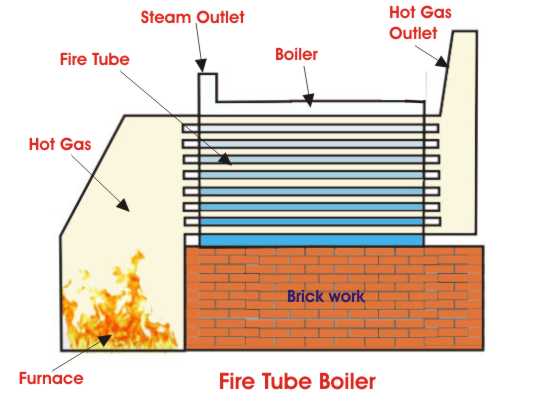
The fuels (normally coal) burnt in the furnace and combustible gasses move into the fire tubes, travel through these tubes from rear to front of the boiler drum and finally the gases come into the smoke box. The hot gasses in the tubes under water transfer heat to the water via the tube walls. Due to this heat energy steam bubbles are created and come upon the water surface. As the amount of steam is increased in that closed drum, steam pressure inside the drum increases which increase significantly the boiling temperature of the water and hence rate of production of steam is reduced. In this way a fire tube boiler controls its own pressure. In other words this is a self pressure controlled boiler.
Advantages of Fire Tube Boiler
- Compact in construction.
- Fluctuation of steam demand can be met easily.
- Cheaper than water tube boiler.
Disadvantages of Fire Tube Boiler
- Due to large water the required steam pressure rising time quite high.
- Output steam pressure cannot be very high since the water and steam are kept in same vessel.
- The steam received from fire tube boiler is not very dry.
- In a fire tube boiler, the steam drum is always under pressure, so there may be a chance of huge explosion which resulting to severe accident.
Water Tube Boiler | Operation and Types of Water Tube Boiler
A water tube boiler is such kind of boiler where the water is heated inside tubes and the hot gasses surround them. This is the basic definition of water tube boiler. Actually this boiler is just opposite of fire tube boilerwhere hot gasses are passed through tubes which are surrounded by water.
Advantages of Water Tube Boiler
There are many advantages of water tube boiler due to which these types of boiler are essentially used in large thermal power station.- Larger heating surface can be achieved by using more numbers of water tubes.
- Due to convectional flow, movement of water is much faster than that of fire tube boiler, hence rate of heat transfer is high which results into higher efficiency.
- Very high pressure in order of 140 kg/cm2 can be obtained smoothly.
Working Principle of Water Tube Boiler
The working principle of water tube boiler is very interesting and simple.Let us draw a very basic diagram of water tube boiler. It consists of mainly two drums, one is upper drum called steam drum other is lower drum called mud drum. These upper drum and lower drum are connected with two tubes namely down-comer and riser tubes as shown in the picture.
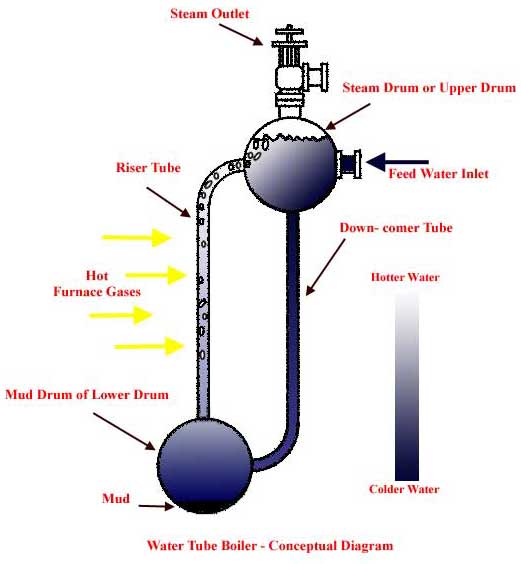 Water in the lower drum and in the riser connected to it, is heated and steam is produced in them which comes to the upper drums naturally. In the upper drum the steam is separated from water naturally and stored above the water surface. The colder water is fed from feed water inlet at upper drum and as this water is heavier than the hotter water of lower drum and that in the riser, the colder water push the hotter water upwards through the riser. So there is one convectional flow of water in the boiler system.More and more steam is produced the pressure of the closed system increases which obstructs this convectional flow of water and hence rate production of steam becomes slower proportionately. Again if the steam is taken trough steam outlet, the pressure inside the system falls and consequently the convectional flow of water becomes faster which result in faster steam production rate. In this way the water tube boilercan control its own pressure. Hence this type of boiler is referred as self controlled machine.
Water in the lower drum and in the riser connected to it, is heated and steam is produced in them which comes to the upper drums naturally. In the upper drum the steam is separated from water naturally and stored above the water surface. The colder water is fed from feed water inlet at upper drum and as this water is heavier than the hotter water of lower drum and that in the riser, the colder water push the hotter water upwards through the riser. So there is one convectional flow of water in the boiler system.More and more steam is produced the pressure of the closed system increases which obstructs this convectional flow of water and hence rate production of steam becomes slower proportionately. Again if the steam is taken trough steam outlet, the pressure inside the system falls and consequently the convectional flow of water becomes faster which result in faster steam production rate. In this way the water tube boilercan control its own pressure. Hence this type of boiler is referred as self controlled machine.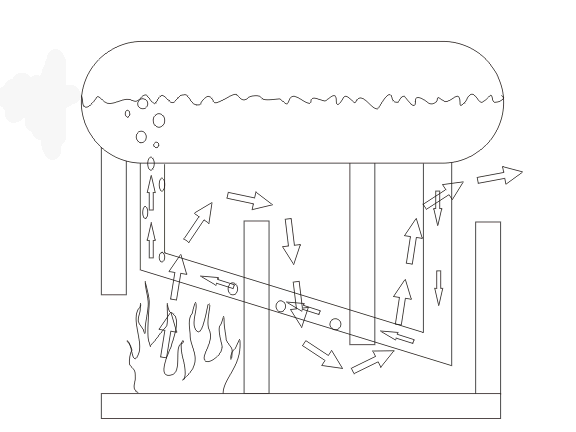
Types of Water Tube Boiler
There are many types of water tube boiler .- Horizontal Straight Tube Boiler.
- Bent Tube Boiler.
- Cyclone Fired Boiler.
- Longitudinal Drum Boiler
- Cross Drum Boiler.
- Two Drum Bent Tube Boiler.
- Three Drum Bent Tube Boiler.
- Low Head Three Drum Bent Tube Boiler.
- Four Drum Bent Tube Boiler.
Horizontal or Longitudinal or Babcock-Wilcox Water Tube Boiler
Construction of Babcock-Wilcox Boiler
Babcock-Wilcox Boiler is also known as Longitudinal Drum Boiler or Horizontal Tubes Boiler. In this type of boiler, one cylindrical drum is longitudinally placed above the heat chamber. In rear of the drum down comer tube is filled and in front of the drum riser tube is fitted as shown in the figure. These down-comer tube and riser tube are connected to each other by 5o to 15o straight water tubes as shown in the figure.Working Principle of Longitudinal Drum Water Tube Boiler
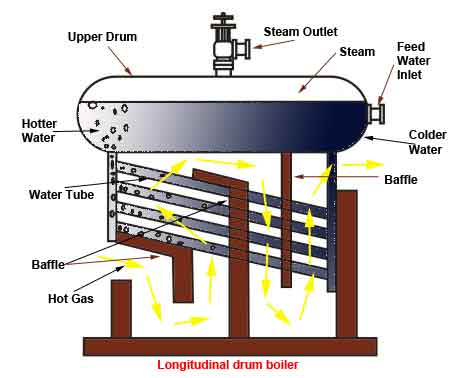 Working principle of Babcock – Wilcox Boiler depends upon thermonyphon principle. The longitudinally placed drum as mentioned in the construction of longitudinal drum boiler, is fed by colder mater at its rear feed water inlet. As the colder water is heavier it falls down through down-comer fitted at the rear part of the drum. From down-comer the water enters in to horizontal water tube where it becomes hot and lighter. As the water becomes lighter, it passes up through these inclined horizontal tubes and ultimately comes back to the boiler drum through riser. During travelling of water through inclined water tubes, it absorbs heat of the hot gases, surrounds the water tube, consequently steam bubbles are created in these tubes. These steam bubbles then come to the steam drum through riser and naturally separated from water and occupies the space above the water surface in the longitudinal drum of Babcock – Wilcox Boiler.
Working principle of Babcock – Wilcox Boiler depends upon thermonyphon principle. The longitudinally placed drum as mentioned in the construction of longitudinal drum boiler, is fed by colder mater at its rear feed water inlet. As the colder water is heavier it falls down through down-comer fitted at the rear part of the drum. From down-comer the water enters in to horizontal water tube where it becomes hot and lighter. As the water becomes lighter, it passes up through these inclined horizontal tubes and ultimately comes back to the boiler drum through riser. During travelling of water through inclined water tubes, it absorbs heat of the hot gases, surrounds the water tube, consequently steam bubbles are created in these tubes. These steam bubbles then come to the steam drum through riser and naturally separated from water and occupies the space above the water surface in the longitudinal drum of Babcock – Wilcox Boiler. Cross Drum Water Tube Boiler
Construction of Cross Drum Water Tube Boiler
Cross Drum Boiler is essentially a variant of the Longitudinal Drum Boiler. In Cross Drum Boiler the steam drum is placed at cross ways to the heat source as shown in the figure. Here, the down-comer is fitted on the bottom of the drum and riser is fitted on the top of the drum via a horizontal tube as shown in the figure. 5o to 15o inclined water tubes are connected with down-comer and riser tubes in same manner of Babcock-Wilcox boiler.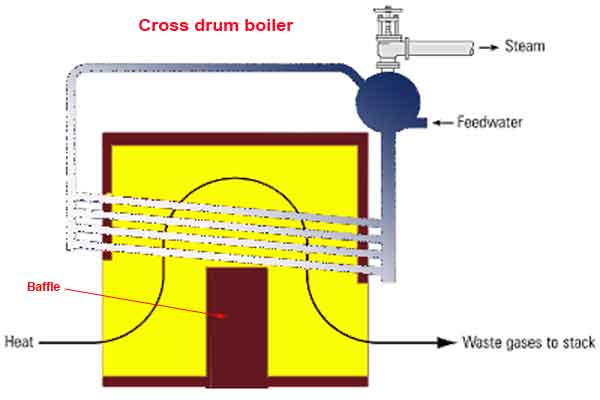
Working Principle of Cross Drum Boiler
The working principle of cross drum boiler is same as longitudinal drum boiler.- The feed water is fed to the cross drum through feed water inlet.
- Then this water comes down through the down-comer pipe and enters into inclined water tube placed in hot chamber.
- Here, the water becomes hot and steam is produced in the water which comes into steam chamber.
- Here in the steam drum steam is separated from water in natural way.
Bend Tube Boiler or Sterling Boiler
Bend Tube Boiler or Sterling Boiler is the developed version of water tube boiler. The working principle of bend tube boiler is more or less same as other water tube boilers, but it utilizes four drums.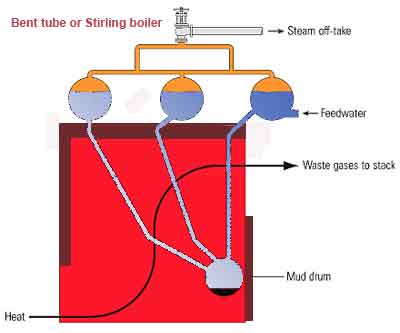
Construction of Bend Tube Boiler
Three drums are placed on the heat source as shown on the figure. Fourth drum is placed inside the heat chamber and this fourth drum is connected to upper three steam drums with help of bend water tube. Upper three drums are connected with equalizer tubes as shown in the figure. Steam is taken from equalizer tubes.Working Principle of Bent Tube or Stirling Boiler
The feed water first enters into right most upper drum. Due to more density this water comes down in the lower water drum. The water within that water drum and the connecting pipes to the other two upper drums, are heated up and consequently steam bubbles are produced. This is the most basic working principle of bent tube boiler.Capacity of Stirling Boiler
Capacity of Stirling Boiler is much higher than Babcock - Wilcox boiler as high as 50,000kg per hour and pressure as high as 60kg/cm 2.Stainless Steel Pipes Tube Price List
Stainless Steel Price in Indonesia
- Stainless Steel 304 Boiler Tubes / Tubing / Pipe Price in Indonesia
US $6.79-9.87 Meter / US $1000-5000 Per Ton / US $3.8-8 Kilogram (Per Kg) - Stainless Steel 304L Boiler Tubes / Tubing / Pipe Price in Indonesia
US $6.79-9.87 Meter / US $1000-5000 Per Ton / US $3.8-8 Kilogram (Per Kg) - Stainless Steel 304H Boiler Tubes / Tubing / Pipe Price in Indonesia
US $6.79-9.87 Meter / US $1000-5000 Per Ton / US $3.8-8 Kilogram (Per Kg) - Stainless Steel 310/310S Boiler Tubes / Tubing / Pipe Price in Indonesia
US $6.79-9.87 Meter / US $1000-5000 Per Ton / US $3.8-8 Kilogram (Per Kg) - Stainless Steel 310H Boiler Tubes / Tubing / Pipe Price in Indonesia
US $6.79-9.87 Meter / US $1000-5000 Per Ton / US $3.8-8 Kilogram (Per Kg) - Stainless Steel 316 Boiler Tubes / Tubing / Pipe Price in Indonesia
US $6.79-9.87 Meter / US $1000-5000 Per Ton / US $3.8-8 Kilogram (Per Kg) - Stainless Steel 316L Boiler Tubes / Tubing / Pipe Price in Indonesia
US $6.79-9.87 Meter / US $1000-5000 Per Ton / US $3.8-8 Kilogram (Per Kg) - Stainless Steel 316H Boiler Tubes / Tubing / Pipe Price in Indonesia
US $6.79-9.87 Meter / US $1000-5000 Per Ton / US $3.8-8 Kilogram (Per Kg) - Stainless Steel 316Ti Boiler Tubes / Tubing / Pipe Price in Indonesia
US $6.79-9.87 Meter / US $1000-5000 Per Ton / US $3.8-8 Kilogram (Per Kg) - Stainless Steel 317/317L Boiler Tubes / Tubing / Pipe Price in Indonesia
US $6.79-9.87 Meter / US $1000-5000 Per Ton / US $3.8-8 Kilogram (Per Kg) - Stainless Steel 321/321H Boiler Tubes / Tubing / Pipe Price in Indonesia
US $6.79-9.87 Meter / US $1000-5000 Per Ton / US $3.8-8 Kilogram (Per Kg) - Stainless Steel 347/347H Boiler Tubes / Tubing / Pipe Price in Indonesia
US $6.79-9.87 Meter / US $1000-5000 Per Ton / US $3.8-8 Kilogram (Per Kg)
WEIGHT CALCULATOR
 Types of weight Calculator :pipe weight calculator, pipe weight calculation formula in mm, how to calculate weight of pipe in kg/m, structural steel weight calculator, ms pipe weight calculation formula in kg, material weight calculation formula, angle weight calculator, Calculator for Seamless steel pipes, Pipe Weight per Foot Calculator, Metal Weight Calculator - Round Pipe Calculator, Square Pipe Calculator, Rectange Pipe Calculator, Hexagon Pipe Calculator, Octagon Pipe Calculator, Sheet Weight Calculator, Plate Weight Calculator, Tubular Pipe Calculator, Ring Weight Calculator, Pipe Weight Calculator / Click Here If You Are Searching Professional Valves Manufacturers in India Citizen Valves Division / Pipe Dimensions
Types of weight Calculator :pipe weight calculator, pipe weight calculation formula in mm, how to calculate weight of pipe in kg/m, structural steel weight calculator, ms pipe weight calculation formula in kg, material weight calculation formula, angle weight calculator, Calculator for Seamless steel pipes, Pipe Weight per Foot Calculator, Metal Weight Calculator - Round Pipe Calculator, Square Pipe Calculator, Rectange Pipe Calculator, Hexagon Pipe Calculator, Octagon Pipe Calculator, Sheet Weight Calculator, Plate Weight Calculator, Tubular Pipe Calculator, Ring Weight Calculator, Pipe Weight Calculator / Click Here If You Are Searching Professional Valves Manufacturers in India Citizen Valves Division / Pipe Dimensions
 Tag : boiler tubes, ibr boiler tube specification, seamless boiler tubes manufacturers, tata boiler tubes, boiler tube manufacturers in india, boiler tubes material specifications, boiler tubes suppliers in india, water tube boiler operation, fire tube boiler, Boiler Tubes High Pressure High Temperature, Boiler tubes and pipes - steel seamless tubes, Boiler Tube Company, Boiler Tubing Price in India
Tag : boiler tubes, ibr boiler tube specification, seamless boiler tubes manufacturers, tata boiler tubes, boiler tube manufacturers in india, boiler tubes material specifications, boiler tubes suppliers in india, water tube boiler operation, fire tube boiler, Boiler Tubes High Pressure High Temperature, Boiler tubes and pipes - steel seamless tubes, Boiler Tube Company, Boiler Tubing Price in India
We have Exported Steel Pipe Tube / Tubing to over 60 countries including India, United Arab Emirates, Kenya, Qatar, USA, Malaysia, South Korea, Indonesia, Singapore, UK, Bangladesh, Japan, China, Thailand, Taiwan, Italy, Iran, Vietnam, Poland, Egypt, Canada, Turkey, Sri Lanka, Pakistan, Saudi Arabia, Kuwait, Russia, Nigeria, France, Denmark, Germany, Greece, Ukraine, Oman, Switzerland, South Africa, Romania, Colombia, Iraq, Australia, Netherlands, Portugal, Spain, Brazil, Norway, Paraguay, Azerbaijan, Trinidad & Tobago, Mexico, Hong Kong, Philippines, Tunisia, Bahrain, Serbia, Belarus
Looking for Stainless Steel boiler tubes Suppliers in Indonesia, Leading Stainless Steel Boiler Tubes Distributors in Indonesia, Largest ASTM A213, A312 SS TP Boiler Tubes Dealers in Indonesia, Top Quality Stainless Steel Boiler Pipes Stockholder in Indonesia, Reliable Exporter of UNS SS Boiler Tubes in Indonesia
boiler tubes, SS Boiler Tubing, ibr boiler tube specification, seamless boiler tubes manufacturers, tata boiler tubes, boiler tube manufacturers in india, boiler tubes material specifications, boiler tubes suppliers in india, water tube boiler operation, fire tube boiler, Boiler Tubes High Pressure High Temperature, Boiler tubes and pipes - steel seamless tubes, Boiler Tube Company, Boiler Tubing
Are Looking for Stainless Steel Boiler Tubes in Indonesia, We can offer a comprehensive range of SS DIN 1.4301 Boiler Tubing. Carrying extensive inventories of Stainless Steel JIS SUS Boiler Tube in Indonesia, Click here if you want to buy Pipes or want to learn about Stainless Steel Boiler Pipes, Reliable Exporter of SS in Boiler Tubing in Indonesia
We Export to: We Import to:
Job Vacancy in Citizen Metals
Share This Page


